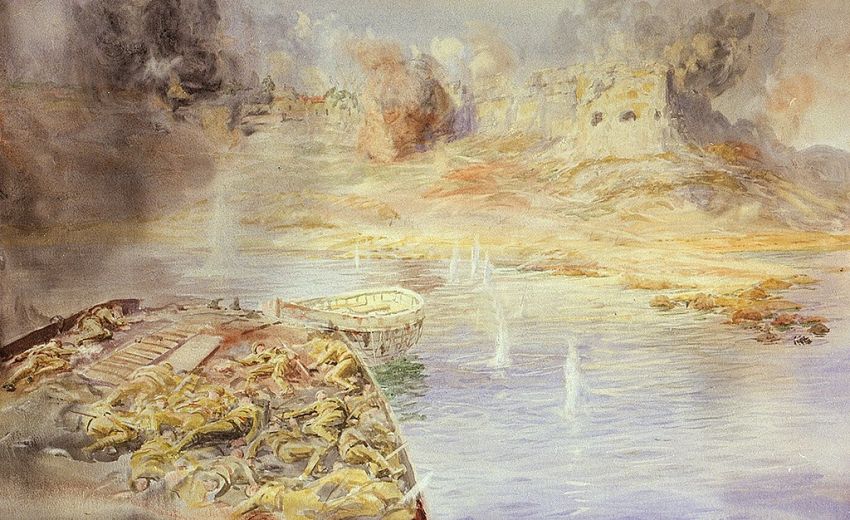
Secular religions are hard to battle in terms of their misplaced assumptions. In some ways, they are even harder to fight than those based on mythical gods and superstitious foundations.
ANZAC, the name of the Australian New Zealand Army Corps, hardly sounds promising as the basis of a religion. But since the needless, bungled operation in the Dardanelles that led to the slaughter of Australian and New Zealand troops in April 1915, along with Turkish, British and French soldiers, the acronym has become meaningful and powerful.
The troops, for the most part, were ignorant of geography and certainly of the myriad nature of European power relations. They found themselves invading the Ottoman Empire in a chess move thought up by Winston Churchill, First Lord of the Admiralty. If the Ottoman Empire could be defeated, imperial Germany would lose a key ally and be exposed on its flank.
The mission failed in spectacular fashion and allowed Kemal Atatürk, the future leader of secular Turkey, to distinguish himself.
Australia, with a population of 5 million, lost 62,000 men from 416,809 enlistees during World War I. Of those, 156,000 were wounded or taken prisoner. More than 3000 men returned with tuberculosis and infected the population accordingly.
The debilities of unrecognised shellshock reigned. This loss disfigured the country irreparably, dulling its optimism for reform. Australian communities turned inward, solemnly pouring savings into the creation of memorials across the country.
ANZAC Day has become a parade for amnesia rather than reckoning, a ritual that rejects peace makers and conciliators in favour of the war mongers and undertakers. Disturbingly, the war mongers are allowed to skip merrily away from responsibility and celebrate character before the bullet and the shell.
Australian soldiers performed heroically and foolishly, before Turkish fire, invasion adventurers who met their demise before the ill-planned stratagems of their superiors. They were material for the empire.
“These raw colonial troops,” wrote British war correspondent Ellis Ashmead-Bartlett, “proved worthy to fight side by side with the heroes of Mons, the Aisne, Ypres and Neuve Chapelle.”
The geography, loyalty and circumstances of the ANZAC myth have troubled a number of Australian historians over the years. Marylyn Lake, in a public lecture given at Melbourne University’s free public series in 2009, was convinced that, “Australia’s identity shouldn’t be built on deaths in foreign fields”.
For Lake, the myth is a bar to the realisation of maturity. “The myth will remain our creation story until the nation is reborn, until we have the courage to detach ourselves from the mother country, declare our independence, inaugurate a republic, draw up a constitution that recognises the first wars of dispossession fought against indigenous peoples.”
ANZAC might have disappeared during the 1960s and 1970s, after seemingly running out of oxygen. Opposition to the Vietnam War helped that process.
Then came the decades of revival: the ANZAC myth became bound to notions of noble, stoic “mateship”, characterised by Peter Weir’s 1981 film Gallipoli. There were cruel and mentally vacant officers, and strikingly brave foot soldiers going to their death with an unquestioning valour.
It was all about, as one implausible assessment went, “brave soldiers keen to prove themselves as representatives of a fledgling nation, albeit one with an ignominious convict past”.
During the years of the conservative John Howard government, after 1996, commemorations and war-time lessons (or mis-teachings), became the norm. The Department of Veteran Affairs became a big fan of ahistorical instruction and hagiographical slurry.
In padding and developing the myth, it was important to exclude a number of things: anti-war movements vanished; the records of criminally incompetent generals and politicians were nowhere to be found; and the misogyny underlying the ideology was also left undiscussed.
ANZAC traditions must resist self-examination and questioning. If questions are asked, they often end up in the kind of execrable analysis that John Roskam of the Institute of Public Affairs offered in 2007. “War is often necessary,” he wrote, “and Australians have answered the call.”
Roskam mentioned the Iraq War, which began as an illegal invasion in 2003, and refused to accept that Australian soldiers were inculpated by the operation. He could only offer this pathetic observation: “One of the things that Anzac Day represents is the willingness of Australians to stand up for what they believe in.”
Australian soldiers are likely to supply the raw material for more wars, including a future one in the Pacific, most likely to be led by the United States. Defence Minister Peter Dutton has been happy to promise the laying down of Australian lives for the US.
The Australian Prime Minister of the day will be able, along with their cabinet, to say that it was a “job well done” — presuming they survive such a conflict. And any moral twinge will be remedied by ceremonial, tear-soaked largesse, in addition the $498 million pencilled in for converting the Australian War Museum into a militarist wonderland.
[Dr Binoy Kampmark lectures at RMIT University.]